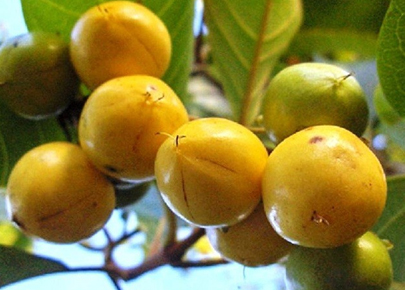To navigate this site you simply hold the cursor over a picture to identify the category then click on that picture to take you to more information or at least a better picture of it.

 Abiu
Abiu
(Pouteria caimito Radlk.)
The Abiu is a spectacular fruit native to the Amazon region of northwest Brazil. The pulp has a smooth creamy texture, and it tastes like caramel flan. Production thus far has been concentrated in southeast Brazil and in Australia, but the coastal regions of south Florida are ideal for the Abiu as well.


Almond
(PTerminalia catappa)
The Abiu is a spectacular fruit native to the Amazon region of northwest Brazil. The pulp has a smooth creamy texture, and it tastes like caramel flan. Production thus far has been concentrated in southeast Brazil and in Australia, but the coastal regions of south Florida are ideal for the Abiu as well.


Aguacatn, Shucte,
(Persea schiedeana)
(Verapaces, 30 species).
Coyo (Persea schiedeana) is a wild tree resembling and closely related to the Avocado (Persea americana). It is classified within the flowering plant family, Lauraceae. It is native to certain areas of Mexico and Panama at altitudes between 1,400 km to 1,900 km. The tree grows to about 20 m high, occasionally reaching 50 m.
Young branches are very hairy. The leaves are deciduous and the flowers are light greenish-yellow, with the stamens turning red with age. The fruit, closely resembling that of the avocado, is generally pear-shaped, with a thick, green, leathery skin. The flesh is oily with a milky juice and tastes like an avocado or coconut. The pear-shaped fruit is easily mistaken for an avocado. However, it contains a much larger central seed. The flesh has stone cells and a gritty texture that is generally considered
unfavorable for edible consumption, despite its appealing taste. The cotyledons, unlike those of the avocado, are pink internally.


Anona, Chancuya
(Annona squamosa)
It is a semi-evergreen shrub or small tree reaching 6-8 m tall. . Tropical fruit tree blooms in the summer, fruits are ripe by October and November. The leaves are
alternate, simple, oblong-lanceolate, 5-17 cm long and 2-5 cm broad. The flowers are produced in clusters of 3-4, each flower
1.5-3 cm across, with six petals, yellow-green spotted purple at the base.
The fruit is usually round or oval, slightly pine cone-like, 6-10 cm diameter and weighing 100-230 g, with a scaly or
lumpy skin. The fruit flesh is edible, white to light yellow, and resembles and tastes like custard. The seeds are
scattered through the fruit flesh; they are blackish-brown, 12-18 mm long, and hard and shiny. The squamosa is also known
as (Sugar-apple, Sweetsop, Ann).


Avacado
(Persea Americana)
Another Persea, but the most popular variety Haas, was developed in Alta Verapaz, Guatemala).


Banana
(Musa acuminata)
["haas" in Mayan] Probably the most important plant in Central America is the banana, please read the page on
agriculture for a better understanding. From its use as a subsistence backyard drop to its role in international politics,
the banana has left its imprint on human ecology in Latin America, it is likely that the banana will be included no matter
what level of the study addressed.
The banana plant has been cultivated for over 4,000 years and has been extensively hybridized. Originally from Asia, it
is really not a tree in the true sense, it is a Heliconia. Instead of having a woody trunk, its trunk is made up of the
remnants of the closely packed leave sheaths formed after the leaves have died and fallen off. It grows from 10 to 30 feet
tall. The banana tree is a sterile hybrid, in spite of bearing flowers, it reproduces through basal suckers at its base and
only produces bananas once per tree.
There are several uses for banana other than food too. Bananas are plants so they do not have a trunk to speak of, they
are layers of leaves. When a plant is cut down, the core can be chopped up and made into a pulp for making paper or bowls.
The leaves themselves are used to wrap things in for cooking like tamales or meats before roasting them in a pit fire.

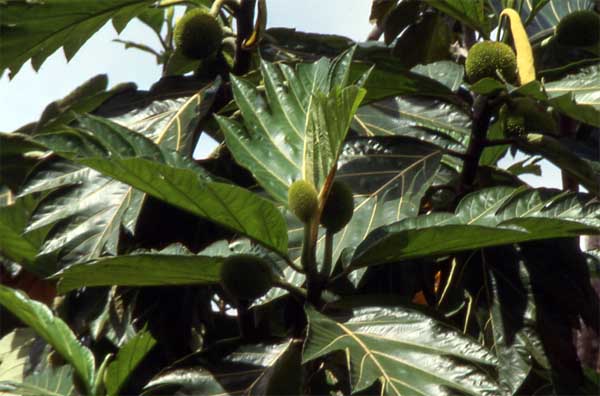
Breadfruit
(Artocapus altilis)
[mazapan] Originally introduced from Tahiti (via England and Captain Bligh of "Mutiny on the Bounty" fame). Probably not surprising is that when
it is deep fried, it tastes just like bread or almost a nutty taste.


Cacao
(Theobroma cacao)
(Cacao) Many tribes thought the cacao plant came from the gods, hence the name Theobroma, meaning "food of the gods." It was used as a currency by the Aztecs and Mayans. After the Spanish conquest of the country in the mid- to late 1500's, cacao became the most important cash crop in the country. Throughout the 1700's the seeds were still used as currency. Coffee soon replaced cacao as the leading export crop, so that by the late 1800's cacao production had virtually ceased.


Caimito
(Chrysophyllum cainito)
Native exotic tropical fruit to the Americas. There are between 70 m- 80 species of these trees here in Central and Northern Southern America.
The leaves are oval, 3-15 cm long, green above, densely golden pubescent below, from which the genus is named. The flowers are small (3-8 mm), purplish white and have a sweet fragrant smell; they are clustered several together, and are hermaphroditic (self fertile). The fruit is edible; round, usually purple skinned (sometimes greenish-white), often green around the calyx, with a star pattern in the pulp; the flattened seeds are light brown and hard. The fruit skin is not edible.


Cashew
(Anacardium occidentale)
Mid April you are apt to see a fruit with an embryonic looking attachment to it. Related to poison ivy, you need to take care before opening a seed pod and eating the cashew itself, but the tangy fruit is good, juicy and stringy right off the tree.


Chico Sapote
(Manilkara zapota)
The Maya called it Sak-ya. The sapodilla tree is the source of a sticky substance that is tapped for the base for chewing gum before
synthetics were introduced called "Chicle". Chicle was the major export of the Petn jungle during the first half of the 20th century. A few
countries, mainly Japan, still import chicle, which, in turn, provides a source of income for those chicleros living in or near the forest. Like
the rubber tree, which also grows wild in the Petn, the sapodilla must be tapped carefully to insure that it will remain alive to provide
chicle over a period of many years. The Sapodilla Tree is a big one, sometimes 40 mts. high, often its trunk is very thick, and the bark is
brown with gray spots, moderately smooth and deeply fissured. The Sapote tree blooms from February to March. This tree lives at 0 to 1200 meters above sea level in dry subtropical forests,
humid subtropical forests and very humid subtropical forest. Its edible fruit, named zapote, tastes like a pear that has been soaked in brown
sugar and is delicious.

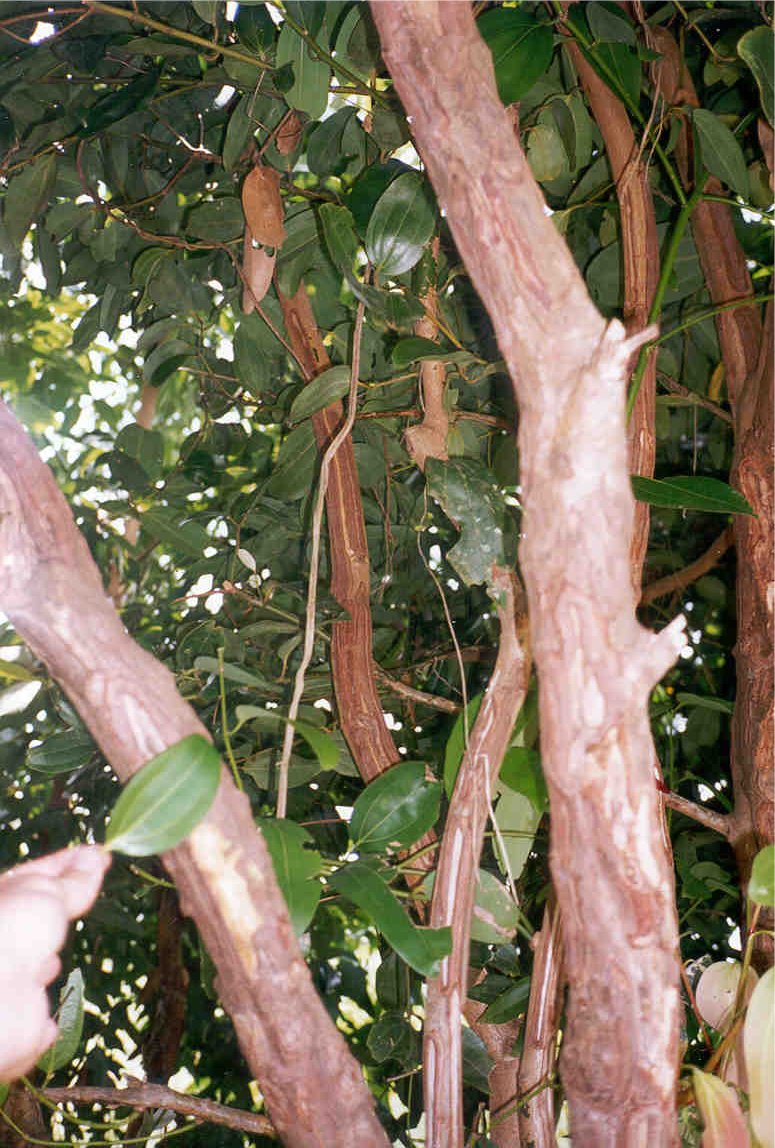
Cinnamon
(Cinnamomum verum)
Cinnamon bark is widely used as a spice for cooking.For cultivation, a tree is grown for two years and the it is coppiced. The next year a dozen of so shoots will form from the roots. These shoots are then stripped of their bark and left to dry. Only the thin inner bark is used; the outer woody portion is removed, leaving
meter long cinnamon strips which curl into rolls on drying.


Coconut
(Cocos nucufera)
(Coco) Although the species is usually found near the sea, it in no sense requires salt for satisfactory growth. In fact, it seems that the species is a poor "competitor," and lives mainly where conditions are not suitable for other species of trees. As long as they are well drained and aerated, coconuts can be grown on almost any kind of soil.


Coffee
(Coffea arabica)
Coffee was shipped from overseas as an ornamental plant as early as 1750 to Guatemala by the Jesuit Fathers. Commercial production did not start until the earliest 1800's in Guatemala and Costa Rica. While El Salvador, Nicaragua, and Honduras started in the second half of the XIX Century.
German immigrants to Guatemala, Nicaragua and Costa Rica were the ones responsible of the industrialization that initiated the trial of the production, processing, and commercialization of coffee in these countries in the XIX Century.
Click on the picture of the coffee beans to see the flowers of the coffee tree.


Guanaba
(Annona muricata)
Guanbana, Guanbanas, Guanbano, Catuche, Catoche, Anona de Mexico, Graviola, Anona de la India, Mole. native to Latin America.


Guava
(Psidium guajava)
Believed to have originated in Central America, guava is a good source of lycopene, beta-carotene, and vitamin C, and is an excellent source of soluble fiber. White delicate flowers bloom in March and by May guava fruits are fully grown; when ripe they have a distinctive sweet fragrance and may reach 5 cm. in diameter. Current research suggests that consumption of guava fruit may reduce LDL (the "bad") serum cholesterol. Another health benefit attributed to guava is its antimicrobial potential in combating certain bacteria such as Staphylococcus aureus and beta-streptococcus group A. Guava is employed as a natural medicine by people who live in the tropics as a treatment for diarrhea.


Jocote
(Spondias purpurea)
Jocote is a species of flowering plant in the family Anacardiaceae, native to tropical regions of the Americas. Other common names include Red Mombin, Purple Mombin, Ciruela, or Hog Plum.
It is a small to medium-sized tree up to 25 m tall. The leaves are deciduous in the short dry season, but only fall shortly before the new leaves develop; they are pinnate, with 7-23 leaflets, each leaflet 3-5 cm long and 1.5-2 cm broad. The flowers are small, reddish-purple, produced in large panicles. The fruit is an edible oval drupe, 3-5 cm long and 2-3.5 cm broad, ripening red (occasionally yellow) and containing a single large seed.
It is now widely cultivated in tropical regions throughout the world for its edible fruit (it is eaten with salt before they ripen), and is also
naturalized in some areas, including the Philippines and Nigeria. Numerous cultivars have been selected for fruit quality. It is also abundant in Central America.


Jocote Maran
(Anacardium occidentale)


Mamey
(Mammea americana)
Mammea is a flowering plant genus with about 50 species in the family Clusiaceae. This large leaf tree has solid trunk and branches forming lush canopy, blooms during March and April, fruits are ripe from May to September. Its members are evergreen trees having edible one-seeded fruits. The flowers are polygamous, with a globular calyx opening into two valvate sepals. There are 4 to 6 petals. Indehiscent drupes are formed, containing 1 to 4 seeds. The leaves are rigid, coriaceous and often have pellucid dots.


Mango
(Magnifera indica)
The mango tree is erect, 30 to 100 ft (roughly 10-30 m) high, with a broad, rounded canopy which may, with age, attain 100 to 125 ft (30-38 m) in width, or a more upright, oval, relatively slender crown. In deep soil, the taproot descends to a depth of 20 ft (6 in), the profuse, wide-spreading, feeder root system also sends down many anchor roots which penetrate for several feet. The tree is long-lived, some specimens being known to be 300 years old and still fruiting.
There is a single, longitudinally ribbed, pale yellowish-white, somewhat woody stone, flattened, oval or kidney-shaped, sometimes rather elongated. It may have along one side a beard of short or long fibers clinging to the flesh cavity, or it may be nearly
fibreless and free. Within the stone is the starchy seed, monoembryonic (usually single-sprouting) or polyembryonic (usually producing more than one seedling).

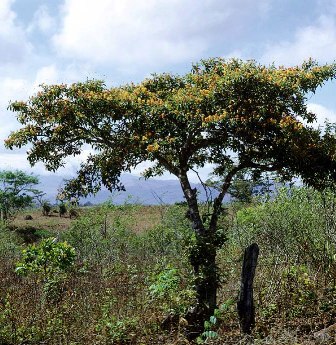
Nancite Malpighiaceae
(Byrsonima crassifolia)
The nance is a slow-growing large shrub or tree to 33 ft (10 m). The tree is native and abundant in the wild, sometimes in extensive stands, in open pine forests and grassy savannas, from southern Mexico, through the Pacific side of Central America, to Peru and Brazil; also occurs in Trinidad, Barbados, Curaao, St. Martin, Dominica, Guadeloupe, Puerto Rico, Haiti, the Dominican Republic and throughout Cuba and the Isle of Pines. The nance is limited to tropical and subtropical climates. In Central and South America, the tree ranges from sea-level to an altitude of 6,000 ft (1,800 m). It is highly drought-tolerant. The fruits are eaten raw or cooked as dessert, or may be included in soup or in stuffing for meats. They are also made into a candy, Dulce de Nance, prepared with the fruit cooked in sugar and water. The fruits are often used to prepare carbonated beverages, flavor mezcal based liquers, or make an oily, acidic, fermented beverage known as chicha, the standard term applied to assorted beer-like drinks made of fruits or maize. Nance is used to distill a rum-like liquor called Crema de nance in Costa Rica.


Papausa
(Annona diversifolia)
This is one more of the 100's of Anona's. Many of them have significant agricultural, medicinal, pharmaceutical, and other
uses.


Papaya
(Carica papaya)
["put" in Mayan] The papaya is a short-lived, quick-growing, soft-wooded tree that has never been found in the wild.Papaya is native to South of Mexico and Central America. They have
been known to be hermaphroditic and able to pollinate themselves. Interestingly, both male and hermaphroditic trees (but never
females) can undergo sex reversal; the type of flower produced on one tree apparently depends on age, season, and probably
other variables as well. In any case, the sex of a tree can not be determined until flowering starts.


Pomarosa
(Syzygium malaccense)
This is related to the Myrtle tree and the genus comprises about 500 species. Not only are there many species of this tree, the
Malay Apple (Syzygium malaccense; syn. Eugenia malaccensis), alone is also known as Mountain Apple, Jambu Bol (Indonesian, meaning ball
guava), Plum Rose, and Pommerac is a fruit native to Malaysia, as well as many Caribbean countries such as Jamaica and Trinidad
and Tobago. The fruit is oblong-shaped and dark red in color, although some varieties have white or pink skin. The flesh is
white and surrounds a large seed. The flesh makes a jam prepared by stewing with brown sugar and ginger. The name Otaheite
Apple is used too (in Jamaica), but should better be used for the Tahitian apple.


Rambutan
(Nephelium lappaceum)
Introduced to Guatemala in 1987 by Dwight Haynes of Frutas del Mundo. In Panama, Costa Rica, and Nicaragua, it is known as mamn chino. You will see these strange fruits in town twice a year in late fall and early winter. Inside their skin is a fruit tasting similar to a grape. The meat surrounds a big seed that you just chew around and enjoy.


Tamarind
(Tamarindus indica L.)
It is a tropical tree, native to eastern Africa, including parts of the Madagascar dry deciduous forests. It grows wild throughout the Sudan but has now been introduced into tropical Asia, Australia, Latin America and the Caribbean.

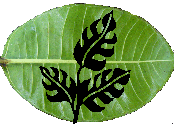

|























